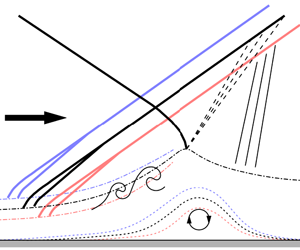Published online by Cambridge University Press: 22 April 2020

Large field-of-view (FOV) particle image velocimetry experiments are conducted in the vicinity of a shock wave boundary layer interaction (SWBLI) at Mach 2. The current FOV covers up to 30 boundary layer thicknesses ( $\widehat{\unicode[STIX]{x1D6FF}}_{I}$), comprising of upstream and downstream regions relative to the SWBLI, thereby allowing the turbulent boundary layer and shock to be simultaneously captured. The relationship between the boundary layer features and the instantaneous shock location is directly quantified, with the aim of better understanding the mechanisms responsible for oscillation of the reflected shock. The results show that the reflected shock location is clearly influenced by the instantaneous state of the incoming boundary layer. It is found that passage of low-/high-momentum very-large-scale turbulent features through the SWBLI region causes the reflected shock to move upstream/downstream of the mean location. Moreover, interaction with the shock is found to introduce additional velocity fluctuations across a range of spanwise length scales within the boundary layer. The spanwise scales smaller than one
$\widehat{\unicode[STIX]{x1D6FF}}_{I}$), comprising of upstream and downstream regions relative to the SWBLI, thereby allowing the turbulent boundary layer and shock to be simultaneously captured. The relationship between the boundary layer features and the instantaneous shock location is directly quantified, with the aim of better understanding the mechanisms responsible for oscillation of the reflected shock. The results show that the reflected shock location is clearly influenced by the instantaneous state of the incoming boundary layer. It is found that passage of low-/high-momentum very-large-scale turbulent features through the SWBLI region causes the reflected shock to move upstream/downstream of the mean location. Moreover, interaction with the shock is found to introduce additional velocity fluctuations across a range of spanwise length scales within the boundary layer. The spanwise scales smaller than one  $\widehat{\unicode[STIX]{x1D6FF}}_{I}$ recover within one
$\widehat{\unicode[STIX]{x1D6FF}}_{I}$ recover within one  $\widehat{\unicode[STIX]{x1D6FF}}_{I}$ downstream of the SWBLI region. However, at larger spanwise wavelengths, two persistent modes at approximately one and six
$\widehat{\unicode[STIX]{x1D6FF}}_{I}$ downstream of the SWBLI region. However, at larger spanwise wavelengths, two persistent modes at approximately one and six  $\widehat{\unicode[STIX]{x1D6FF}}_{I}$ are observed, where they remain correlated for a longer streamwise extent (
$\widehat{\unicode[STIX]{x1D6FF}}_{I}$ are observed, where they remain correlated for a longer streamwise extent ( $\gg \widehat{\unicode[STIX]{x1D6FF}}_{I}$) than the other spanwise modes. The wall pressure measurements indicate that the low-frequency fluctuations arising from the oscillating shock foot are due to dampening of high-frequency contents beyond the critical frequency associated with the unstable global mode. Thus, the results suggest that low-frequency pressure oscillations are not necessarily an independent phenomenon from the turbulent features entering the SWBLI region and interacting with the shock. Instead, a large scale separation between their dominant time scales is due to the critical frequency of the unstable global mode occurring at frequencies that are orders of magnitudes slower than the dominant frequency of the very-large-scale features.
$\gg \widehat{\unicode[STIX]{x1D6FF}}_{I}$) than the other spanwise modes. The wall pressure measurements indicate that the low-frequency fluctuations arising from the oscillating shock foot are due to dampening of high-frequency contents beyond the critical frequency associated with the unstable global mode. Thus, the results suggest that low-frequency pressure oscillations are not necessarily an independent phenomenon from the turbulent features entering the SWBLI region and interacting with the shock. Instead, a large scale separation between their dominant time scales is due to the critical frequency of the unstable global mode occurring at frequencies that are orders of magnitudes slower than the dominant frequency of the very-large-scale features.